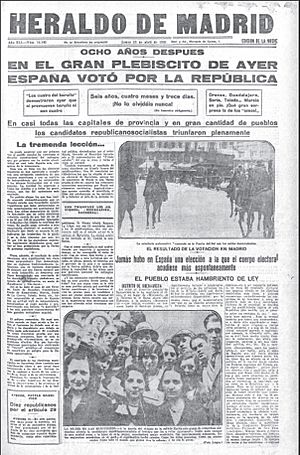Heraldo de Madrid facts for kids
 |
|
| Type | Daily newspaper |
|---|---|
| Founder(s) | Felipe Ducazcal |
| Founded | 29 October 1890 |
| Political alignment | Liberalism (earlier) Republicanism (since 1927) |
| Language | Spanish |
| Ceased publication | 27 March 1939 |
| Headquarters | Madrid |
| Country | Spain |
The Heraldo de Madrid was a Spanish newspaper that was published every day, usually in the evening. It started in 1890 and stopped being published in 1939. Over time, it became known for supporting Republican ideas.
Contents
History of the Heraldo de Madrid
How the Newspaper Started
The Heraldo de Madrid began on October 29, 1890. It was founded by Felipe Ducazcal Lasheras. He was a friend of King Amadeo I.
After Ducazcal passed away in 1891, Eugenio González Sangrador bought the newspaper. In 1893, two brothers, José and Luis, bought it. They were joined by many of José Canalejas's political friends.
Growing Influence and Political Views
The newspaper quickly became very important. It was the main voice for José Canalejas's Liberal political group. Liberals generally believe in individual rights and freedoms.
Around 1906, a company called the Sociedad Editorial de España bought the Heraldo. The newspaper then started to support Segismundo Moret. He was a rival of José Canalejas within the Liberal party.
Changes and Challenges
In 1918, the Busquets brothers, Manuel and Juan, became the owners. They also owned another company called Sociedad Editorial Universal.
In 1927, Manuel Fontdevila was hired as the editor. From this point on, the Heraldo de Madrid became a newspaper that supported Republican ideas. Republicans believe that a country should be governed by elected representatives, not a king or queen.
Facing Difficult Times
The Heraldo de Madrid was very popular in Madrid. However, it faced many challenges during the dictatorship of Primo de Rivera. This was a time when Spain was ruled by a military leader. Despite these difficulties, many people who worked for the newspaper were elected to the Spanish Parliament in 1931.
The Spanish Civil War and the End
When the Spanish Civil War began, the newspaper faced even more danger. A rebel general, Juan Yagüe, made threats against the newspaper's director. This happened in September 1936, after the rebels took over Talavera de la Reina.
The Francoist forces did not enter Madrid in 1936. So, the newspaper continued to publish for more than two years. Federico Morena became the director in 1937. The newspaper kept going, even with fewer staff members.
The very last issue of the Heraldo de Madrid was published on March 27, 1939. The next day, the Francoist army entered Madrid. The newspaper's offices were taken over by a group called Falangists. These offices were located on calle del Marqués de Cubas. Another newspaper, called Madrid, then started publishing from there. It was edited by Juan Pujol.
Editors of the Heraldo
Many different people led the Heraldo de Madrid as its editor. Here are some of them:
- Augusto Suárez de Figueroa (1890–1893)
- José Gutiérrez Abascal, known as "Kasabal" (1893–1902)
- José Francos Rodríguez (1902–1906)
- Baldomero Argente (1906–1909)
- José Rocamora (1909–1926)
- Manuel Fontdevila (1927–1936)
- Alfredo Cabanillas Blanco (1936–1937)
- Federico de la Morena (1937–1939)
Famous Writers and Contributors
The Heraldo de Madrid had many talented writers and reporters. Some of the most famous people who contributed to the newspaper include:
- José Echegaray
- Ramiro de Maeztu
- Carmen de Burgos (who used the pen name "Colombine")
- Ramón del Valle-Inclán
- Isabel Oyarzábal
- Manuel Chaves Nogales
See also
 In Spanish: Heraldo de Madrid para niños
In Spanish: Heraldo de Madrid para niños

